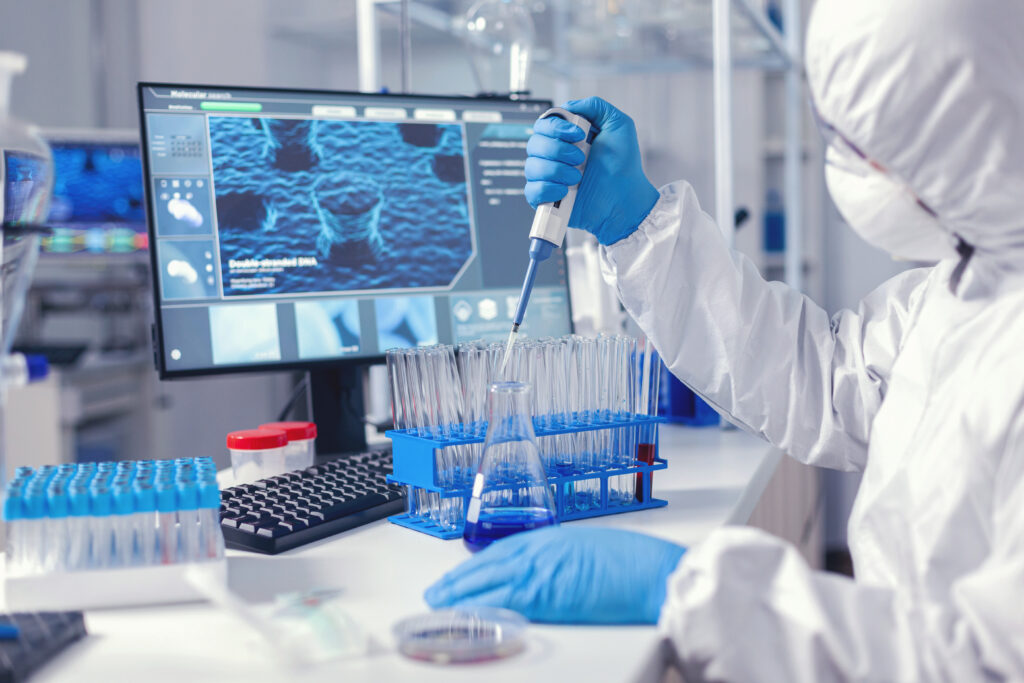1. Digital Transformation and Industry 4.0 Adoption
1.1 Core Components of Digital Transformation in Pharma
Internet of Things (IoT)
IoT devices are being utilized to monitor equipment, track materials, and collect data in real-time. This connectivity enhances transparency and enables predictive maintenance, reducing downtime.
Artificial Intelligence (AI) and Machine Learning (ML)
AI and ML algorithms are optimizing manufacturing processes by analyzing data to improve yield, reduce variability, and predict trends.
Cloud Computing
Cloud-based platforms provide a centralized system for storing and analyzing data, facilitating seamless communication and collaboration across global manufacturing facilities.
1.2 Smart Manufacturing in Industry 4.0
Automation and Robotics
Robotic systems and automated equipment are revolutionizing production lines, performing repetitive tasks with precision and speed while minimizing human error.
Digital Twin Technology
Digital twins, virtual replicas of physical processes, are being used to simulate and optimize manufacturing operations, reducing risks and speeding up production cycles.
1.3 Benefits of Digital Transformation in Pharmaceutical Manufacturing
Enhanced Productivity
Digital tools enable efficient resource management and faster production cycles, increasing overall productivity.
Improved Quality Control
Automated systems and real-time monitoring ensure consistent quality by detecting deviations early and maintaining stringent regulatory compliance.
Cost Reduction
By minimizing waste, preventing equipment failures, and optimizing processes, digital transformation significantly reduces manufacturing costs.
1.4 Challenges in Implementing Industry 4.0
High Initial Investment
The integration of advanced technologies requires substantial capital investment, which can be a barrier for small and medium-sized manufacturers.
Data Security Concerns
With increased connectivity comes the risk of cybersecurity threats. Ensuring data integrity and privacy is critical.
Workforce Adaptation
The shift towards digital manufacturing demands a workforce skilled in technology, requiring significant investment in training and upskilling.
1.5 Future Trends in Digital Transformation
Advanced Analytics for Predictive Insights
The use of advanced analytics will continue to grow, enabling better forecasting of market demands and production needs.
Integration of Blockchain
Blockchain technology will be increasingly adopted for ensuring transparency and traceability across the pharmaceutical supply chain.
Personalized Medicine Manufacturing
Digital technologies will enable the production of personalized medicines, catering to the specific needs of individual patients.
2. Rise of Continuous Manufacturing
2.1 Shift from Batch to Continuous Processes
The transition from traditional batch manufacturing to continuous manufacturing is gaining momentum. This approach reduces production time, enhances scalability, and ensures consistent product quality.
2.2 Regulatory Support for Continuous Manufacturing
Regulatory bodies like the FDA are actively promoting continuous manufacturing due to its potential to improve drug supply reliability and reduce shortages.
3. Increased Focus on Sustainable Manufacturing
3.1 Adoption of Green Chemistry Principles
Pharmaceutical companies are integrating green chemistry practices to reduce waste, lower energy consumption, and minimize the environmental impact of manufacturing processes.
3.2 Circular Economy in Pharma
The adoption of circular economy principles, such as recycling and reusing materials, is becoming a priority. Companies are also exploring biodegradable materials for packaging.
4. Advanced Automation and Robotics
4.1. Applications of Automation in Pharmaceutical Manufacturing
Production Line Automation
Automated production lines handle tasks like mixing, filling, capping, and labeling with high precision and speed, enhancing throughput and consistency.
Quality Control and Assurance
Advanced sensors and vision systems automate quality inspections, ensuring that only compliant products reach the market. Automated systems can detect minute defects that human eyes might miss.
Material Handling
Automated guided vehicles (AGVs) and robotic arms are transforming material handling, reducing manual labor and streamlining workflows in warehouses and production facilities.
4.2. Role of Robotics in Pharmaceutical Manufacturing
Precision in Complex Tasks
Robots excel in performing intricate tasks such as assembling drug delivery devices or handling biologics that require sterile conditions and exact measurements.
Robotic Process Automation (RPA) in Documentation
RPA software automates repetitive documentation tasks, such as regulatory filings and batch records, ensuring accuracy and saving time.
Collaborative Robots (Cobots)
Cobots are designed to work alongside human operators, enhancing productivity while maintaining safety. They are increasingly used in packaging, palletizing, and inspection processes.
4.3 Benefits of Automation and Robotics in Pharma
Enhanced Efficiency
Automation reduces bottlenecks and downtime, enabling faster production cycles and improved operational efficiency.
Consistent Quality
Robotics ensures uniformity in production and packaging, minimizing the risk of human-induced variability.
Cost-Effectiveness
By reducing labor costs and waste, automation delivers long-term financial benefits. It also helps pharmaceutical companies scale up production without compromising quality.
Improved Workplace Safety
Automation and robotics minimize direct human involvement in hazardous tasks, such as handling toxic substances or working in high-temperature environments.
4.4. Challenges in Adopting Automation and Robotics
High Implementation Costs
The initial investment in automation technologies can be significant, particularly for small and medium-sized enterprises.
Integration with Legacy Systems
Integrating new technologies with existing systems requires careful planning and significant resources.
Skill Gap in the Workforce
Implementing and maintaining automated systems necessitates a skilled workforce, requiring companies to invest in training and upskilling employees.
4.5. Emerging Trends in Automation and Robotics for 2024
Artificial Intelligence Integration
AI-powered robotics are becoming increasingly prevalent, enabling smarter decision-making and adaptive responses in manufacturing processes.
Autonomous Quality Control
Autonomous systems that combine robotics with machine learning are redefining quality control by detecting defects in real time and recommending corrective actions.
Modular Automation Systems
Modular systems offer flexibility in scaling up or modifying production processes, making them ideal for personalized medicine manufacturing.
4.6. Case Studies: Successful Automation in Pharma
Automation in Vaccine Production
Robotic systems have been pivotal in ramping up vaccine production, ensuring precision, sterility, and efficiency during the COVID-19 pandemic and beyond.
Robotics in Biologics Manufacturing
Leading pharmaceutical companies are utilizing robotic arms for the sterile handling and assembly of biologics, reducing contamination risks and enhancing yield.
4.7 Future of Automation and Robotics in Pharma
The integration of advanced automation and robotics will continue to grow, driven by technological advancements and evolving market needs. Innovations like AI-powered robots, autonomous systems, and modular automation will shape the future of pharmaceutical manufacturing, making it more agile, efficient, and responsive to global healthcare demands.
5. Biopharmaceutical Manufacturing Innovations
5.1 Key Innovations in Biopharmaceutical Manufacturing
Continuous Manufacturing
Continuous manufacturing replaces traditional batch processes with uninterrupted production, leading to improved efficiency and reduced time-to-market. It enhances product quality by maintaining consistent process conditions.
Single-Use Technologies
Single-use systems (SUS), such as disposable bioreactors and tubing, are becoming standard in biopharmaceutical production. They reduce the risk of contamination, lower cleaning and validation requirements, and enable faster changeovers.
Process Intensification
Process intensification involves optimizing existing manufacturing methods to achieve higher yields with fewer resources. Techniques such as high-density cell culture systems and advanced filtration methods are key contributors.
3D Bioprinting
3D bioprinting is emerging as a cutting-edge tool in biopharmaceutical R&D. It enables the creation of complex biological structures, such as tissues and organ models, for testing and development.
5.2 Emergence of Smart Manufacturing Technologies
Artificial Intelligence (AI) and Machine Learning (ML)
AI and ML are revolutionizing process development, enabling predictive analytics, real-time monitoring, and optimization of production workflows. These technologies minimize errors and enhance productivity.
Digital Twins
Digital twin technology creates virtual replicas of manufacturing processes, allowing manufacturers to simulate, predict, and optimize production in real time without disrupting operations.
Internet of Things (IoT)
IoT sensors enable real-time monitoring of critical parameters in bioreactors, storage systems, and distribution networks, ensuring compliance and quality.
5.3 Advancements in Upstream and Downstream Processes
Upstream Process Innovations
Advanced cell line engineering, high-performance media, and automation in bioreactor operations are transforming upstream processes, resulting in higher cell densities and improved productivity.
Downstream Process Innovations
Efficient purification techniques, such as continuous chromatography and membrane filtration, are addressing bottlenecks in downstream processing, reducing costs, and improving yields.
5.4 Adoption of Green and Sustainable Practices
Bioprocessing Sustainability
Manufacturers are adopting greener processes, including the use of renewable raw materials, energy-efficient equipment, and waste minimization techniques.
Carbon-Neutral Production
Efforts to achieve carbon neutrality in manufacturing are gaining traction, with innovations such as energy recovery systems and eco-friendly single-use technologies.
5.5 Applications of Cutting-Edge Biopharmaceutical Manufacturing
Cell and Gene Therapy Production
Innovations are driving the production of cell and gene therapies, enabling personalized treatments for conditions like cancer and genetic disorders. Scalable manufacturing solutions are making these therapies more accessible.
mRNA Vaccine Manufacturing
The success of mRNA vaccines during the COVID-19 pandemic has spurred advancements in their production, including scalable processes and improved stability techniques.
Biosimilars Development
Innovative manufacturing strategies are reducing the cost and complexity of biosimilar production, increasing their availability in global markets.
5.6 Challenges in Biopharmaceutical Manufacturing Innovations
Regulatory Hurdles
Adapting regulatory frameworks to accommodate novel manufacturing techniques remains a significant challenge.
High Initial Investment
The cost of implementing advanced technologies and facilities can be prohibitive for smaller companies.
Workforce Expertise
A skilled workforce is essential to manage sophisticated processes, necessitating significant investment in training and development.
5.7 Future Trends in Biopharmaceutical Manufacturing
Personalized Medicine Scaling
Advances in manufacturing will enable scalable production of personalized therapies, including individualized vaccines and treatments.
Automation and Robotics Expansion
Increased automation in biopharmaceutical manufacturing will reduce costs, improve precision, and enhance safety.
Integration of Blockchain for Traceability
Blockchain technology will provide enhanced transparency and traceability in supply chains, ensuring the integrity of biopharmaceutical products.
6. Regulatory Compliance and Quality Assurance
6.1 Strengthened Data Integrity Protocols
In 2024, there is heightened scrutiny on data integrity, with companies implementing robust systems to ensure compliance with global regulatory standards.
6.2 Global Harmonization of Standards
Efforts are underway to harmonize pharmaceutical manufacturing standards worldwide, simplifying compliance for companies operating across borders.
7. Artificial Intelligence and Machine Learning
7.1 Applications of AI and ML in Pharmaceutical Manufacturing
Process Optimization
AI-powered systems analyze production data to identify inefficiencies, optimize workflows, and predict equipment maintenance needs, ensuring minimal downtime.
Quality Control and Assurance
AI systems equipped with advanced imaging and data analysis capabilities can detect defects, monitor production quality, and ensure adherence to stringent regulatory standards.
Drug Formulation and Design
ML algorithms accelerate the formulation process by analyzing vast datasets to predict the stability, efficacy, and bioavailability of new drugs.
Supply Chain Management
AI enhances supply chain efficiency by forecasting demand, managing inventory, and optimizing logistics, reducing waste and ensuring timely delivery.
7.2 Key Trends in AI and ML Adoption in 2024
Predictive Analytics in Manufacturing
Predictive analytics use historical data to forecast potential issues in production, enabling proactive interventions. For example, ML models predict batch failures, reducing waste and saving costs.
Digital Twins
Digital twins create virtual replicas of manufacturing processes. These AI-driven models simulate real-world scenarios, allowing manufacturers to test and optimize production without physical disruptions.
Autonomous Systems
AI-enabled autonomous systems manage tasks like material handling and equipment adjustments, improving efficiency and reducing human intervention.
AI-Driven Regulatory Compliance
AI systems simplify compliance by automating documentation, monitoring regulatory changes, and ensuring that manufacturing processes align with global standards.
7.3 Benefits of AI and ML in Pharmaceutical Manufacturing
Improved Efficiency
AI and ML streamline operations, automate repetitive tasks, and ensure faster production cycles, leading to cost savings and increased productivity.
Enhanced Product Quality
Machine learning models detect anomalies and predict deviations in real time, ensuring consistent product quality and reducing recalls.
Cost Reduction
AI reduces operational costs by optimizing resource utilization, minimizing waste, and automating labor-intensive processes.
Accelerated Drug Development
AI-driven analytics shorten the drug development timeline by identifying promising compounds and optimizing clinical trial designs.
7.4 Challenges in Implementing AI and ML
Data Quality and Availability
High-quality data is essential for effective AI and ML implementation. However, inconsistent or incomplete data can limit the potential of these technologies.
High Initial Investment
The deployment of AI and ML systems involves significant costs, including software, hardware, and skilled personnel, which can be challenging for smaller companies.
Regulatory and Ethical Concerns
AI-driven decisions in pharmaceutical manufacturing must comply with stringent regulatory frameworks, and ensuring transparency in these decisions is critical to building trust.
Workforce Adaptation
The integration of AI and ML requires a skilled workforce capable of managing and interpreting advanced technologies, necessitating substantial investment in training and upskilling.
7.5 Emerging Innovations in AI and ML for 2024
Generative AI for Drug Discovery
Generative AI models, such as deep learning algorithms, are revolutionizing drug discovery by predicting molecular structures and identifying new drug candidates.
Real-Time Process Monitoring
AI systems equipped with IoT sensors enable real-time monitoring of manufacturing processes, offering actionable insights to enhance efficiency and quality.
AI-Enhanced Biopharmaceutical Production
ML algorithms optimize cell culture conditions, predict protein yields, and monitor bioreactor performance in biopharmaceutical manufacturing.
7.6 Case Studies: Success Stories of AI and ML in Pharma
AI in Vaccine Production
During the COVID-19 pandemic, AI algorithms accelerated vaccine development and optimized manufacturing processes, reducing production timelines significantly.
Predictive Maintenance at Pfizer
Pfizer implemented AI-based predictive maintenance systems to monitor equipment health, reducing unplanned downtime and increasing production efficiency.
Drug Formulation at Novartis
Novartis uses ML algorithms to analyze large datasets and refine drug formulations, achieving higher success rates in clinical trials.
7.7 Future Outlook for AI and ML in Pharmaceutical Manufacturing
The adoption of AI and ML will continue to expand in pharmaceutical manufacturing, driven by advancements in computing power, algorithm development, and industry collaboration. Key areas of focus include:
- Greater integration of AI in biopharmaceutical production.
- Development of regulatory frameworks for AI-driven decision-making.
- Enhanced focus on sustainability through AI-optimized processes.
8. Advanced Drug Delivery Systems
8.1 Types of Advanced Drug Delivery Systems
Controlled Release Systems
These systems release drugs at a predetermined rate, ensuring consistent therapeutic levels over an extended period. Examples include osmotic pumps and polymer-based systems.
Targeted Drug Delivery Systems
Targeted delivery uses ligands, nanoparticles, or liposomes to direct drugs specifically to diseased tissues or cells, minimizing effects on healthy tissues.
Transdermal Drug Delivery
Transdermal patches and microneedle systems enable drugs to be absorbed through the skin, offering non-invasive alternatives to injections.
Implantable Devices
Implantable drug delivery devices release medications over months or years, ideal for chronic conditions like diabetes or cancer.
Inhalable Drug Delivery
Inhalers and nebulizers provide rapid delivery of medications to the respiratory system, commonly used for asthma and chronic obstructive pulmonary disease (COPD).
8.2 Innovations in Drug Delivery Technologies
Nanotechnology in Drug Delivery
Nanoparticles enhance drug solubility, stability, and targeted delivery, improving therapeutic outcomes and reducing dosages.
Biodegradable Polymers
Biodegradable polymers are increasingly used to create drug carriers that dissolve safely in the body after releasing their payload.
Smart Drug Delivery Systems
Smart systems integrate sensors and microelectronics to release drugs in response to physiological signals, such as pH, temperature, or glucose levels.
3D Printing of Drug Delivery Devices
3D printing technology is enabling customized drug delivery devices, including tablets and implants, tailored to individual patient needs.
8.3 Applications of Advanced Drug Delivery Systems
Oncology
Targeted drug delivery systems like antibody-drug conjugates (ADCs) are revolutionizing cancer treatment by delivering cytotoxic agents directly to tumor cells.
Neurological Disorders
Intranasal and implantable systems are enhancing the delivery of drugs to the brain, overcoming the blood-brain barrier.
Chronic Diseases
Controlled-release and implantable devices ensure consistent drug levels for chronic diseases like diabetes, hypertension, and rheumatoid arthritis.
Vaccines and Biologics
Innovative delivery systems, such as lipid nanoparticles, are improving the stability and delivery of mRNA-based vaccines and biologics.
8.4 Benefits of Advanced Drug Delivery Systems
Improved Patient Compliance
Non-invasive systems and long-acting formulations reduce the frequency of drug administration, improving adherence.
Enhanced Therapeutic Efficacy
Targeted and controlled delivery minimizes drug wastage and ensures maximum therapeutic impact.
Reduced Side Effects
By concentrating drug action on diseased areas, ADDS significantly reduce systemic side effects.
Cost-Effectiveness
Efficient drug use and reduced hospitalization due to better treatment outcomes contribute to overall cost savings.
8.5 Challenges in Implementing Advanced Drug Delivery Systems
High Development Costs
The development of advanced systems involves significant R&D investments, which can be a barrier for small and mid-sized companies.
Regulatory Hurdles
Stringent regulatory requirements and the need for extensive clinical testing slow down the adoption of new drug delivery technologies.
Manufacturing Complexities
Producing advanced systems requires specialized equipment, expertise, and infrastructure, posing challenges for scalability.
Limited Awareness
Healthcare providers and patients may lack awareness about the benefits and availability of these technologies.
8.6 Future Trends in Advanced Drug Delivery Systems
Integration with Digital Health
Combining drug delivery systems with digital health tools, such as wearable sensors, will enable real-time monitoring and personalized dosing.
Focus on Biologics
As biologics gain prominence, the development of delivery systems tailored for proteins, peptides, and nucleic acids will accelerate.
Patient-Centric Designs
Drug delivery systems will increasingly focus on patient comfort, portability, and ease of use, ensuring better compliance.
Sustainability in Drug Delivery
Eco-friendly materials and biodegradable systems will gain traction, aligning with global sustainability goals.
9. Workforce Upskilling and Training
9.1 Digital Skills Development
With the integration of advanced technologies, companies are investing in training programs to upskill their workforce in digital and analytical competencies.
9.2 Collaborative Partnerships with Academia
Pharmaceutical companies are partnering with academic institutions to create tailored training programs that align with industry needs.
10. Supply Chain Resilience
10.1 Diversification of Suppliers
Companies are diversifying their supplier base to mitigate risks associated with geopolitical tensions and global supply chain disruptions.
10.2 Blockchain for Supply Chain Transparency
Blockchain technology is being adopted to enhance transparency and traceability in the pharmaceutical supply chain, ensuring product authenticity.
11. Conclusion
The pharmaceutical manufacturing industry in 2024 is characterized by innovation, sustainability, and adaptability. By embracing these trends, companies are not only enhancing their operational efficiency but also ensuring better patient outcomes. Staying abreast of these developments is crucial for maintaining a competitive edge in this dynamic sector.
For more articles, Kindly Click here.
For pharmaceutical jobs, follow us on LinkedIn
For Editable SOPs in Word format contact us on info@pharmaceuticalcarrier.com
For more information kindly follow us on www.pharmaguidelines.co.uk



